Japanese weeks in the asteroid belt
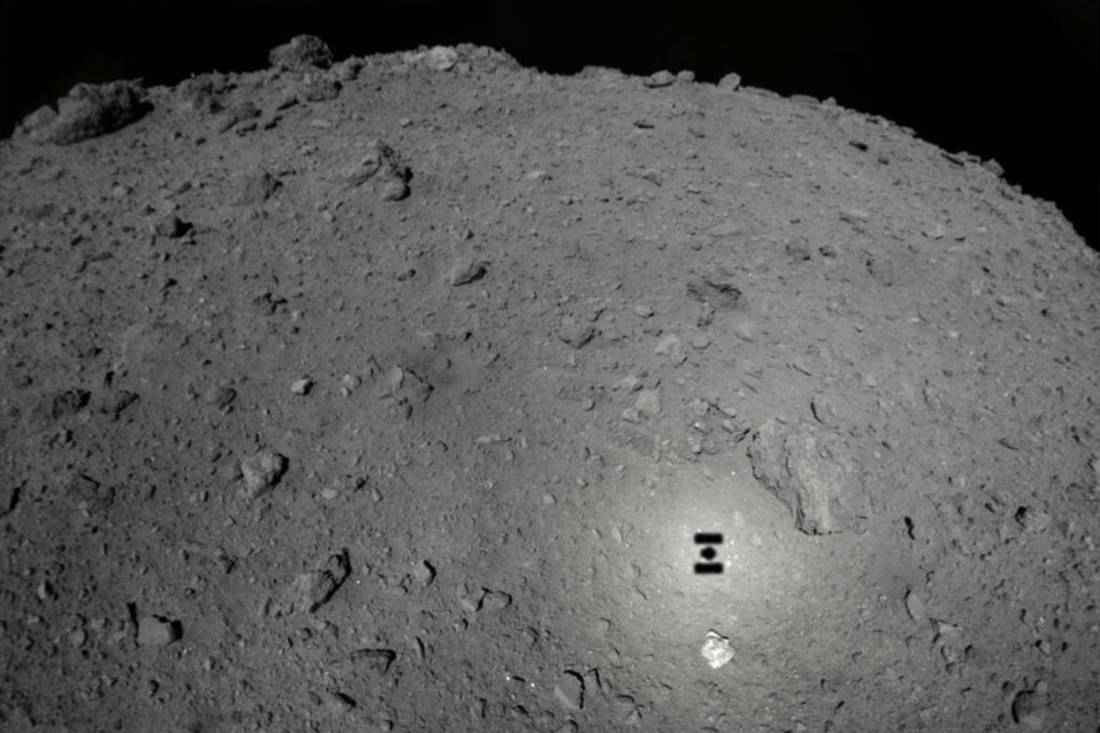
In the coming months, asteroids will be particularly relevant. No, they will not fall on Earth. The earth will fall upon them. More precisely, terrestrial products will consider them from close range, descend to the surface, seize, shoot and bomb. The first revenge for Chelyabinsk is taken by the Japanese.
Three spacecraft immediately went on the hunt for asteroids. The Japanese Hayabusa 2 is already exploring the asteroid Ryugu. An expedition of the American OSIRIS-REx near the asteroid Bennu is expected next. And by the New Year, the interstellar probe New Horizons will show us the small space body of Ultima Thule, which will be studied at close range.
Hayabusa 2 is the second attempt by the Japanese space agency JAXA to conquer the asteroid. The first Hayabusa also brought some results from the Itokawa asteroid, and even a pinch of asteroid ground weighing less than a gram. In 2005, the asteroid was examined at close range, obtaining unique data on its structure and formation.
')
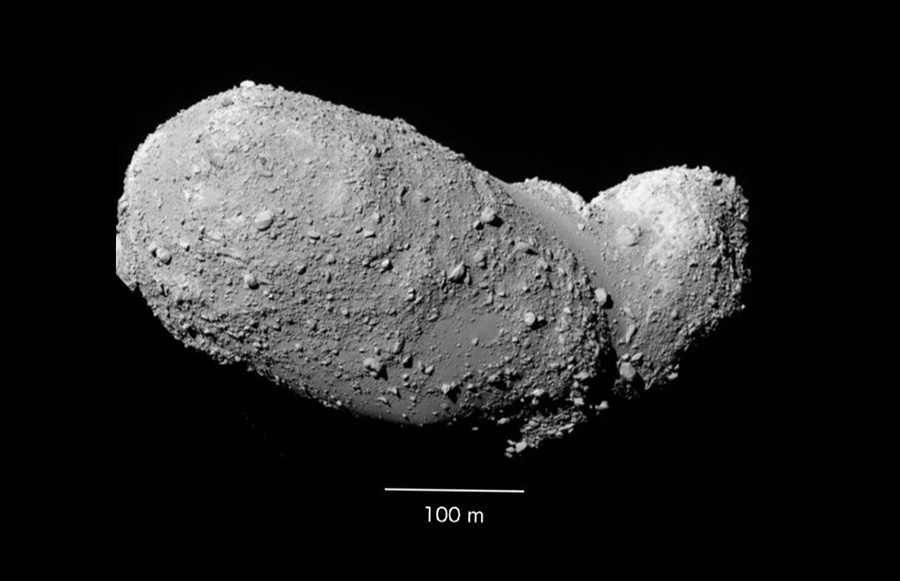
For him, even identified a separate type of asteroid - "a pile of rubble ." This is a very loose cosmic body, formed from small and large stones, connected by gravity and Van-der-Waals forces (the forces of weak electromagnetic interaction at the molecular level, thanks to them, for example, geckos can crawl on glass).
Despite the success of the Hayabusa, there were many problems and failures in its flight. The MINERVA descent vehicle did not show signs of life, there were problems with the engines, the on-board computer and solar panels, and the ground could collect an insignificantly small amount. The return occurred three years after the scheduled date. Therefore, JAXA decided to take revenge. The next time we conducted a thorough work on the bugs and while the expedition is developing quite successfully.
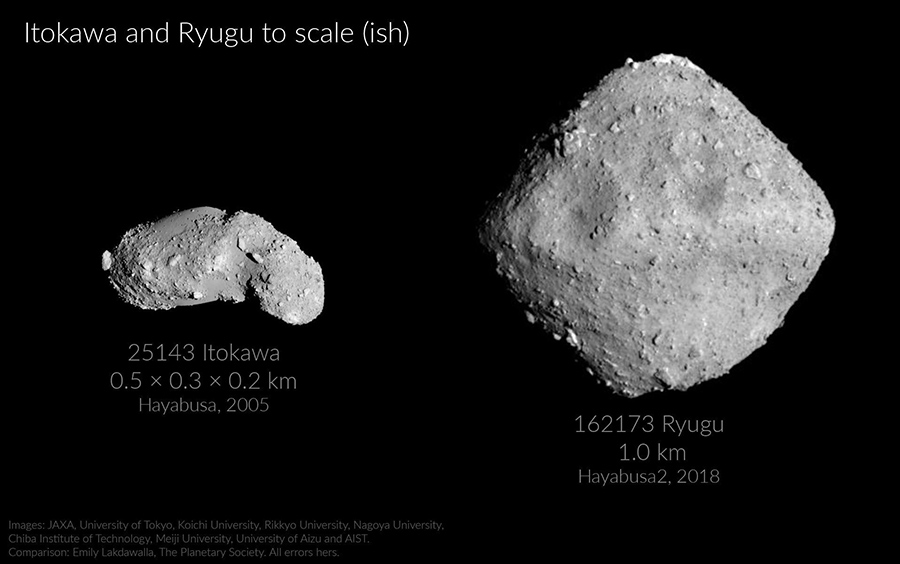
Hayabusa 2 was launched in 2014, and the interplanetary space set off, making a flight around the Sun to reach the trajectory of convergence with a new goal - asteroid Ryugu. This is a typical asteroid of the most widespread spectral class C of the Apollo family, slightly smaller than a kilometer in size, having a slightly elongated orbit that in the far part intersects the orbit of Mars, and in the near part - of the Earth. It is expected that the materials of this asteroid belong to the gas-dust disk from which all the bodies of the Solar system were formed, i.e. This study - an attempt to look at 4.6 billion years in the past - even before the appearance of the Earth. True, the original “building material” of the Solar System includes the majority of meteorites, chondrites, which already fall to Earth, and Ryugu does not stand out in anything special, except for having a convenient orbit, which simplifies its achievement.
The design of Hayabusa 2 largely repeats the previous device of the same name. A service platform with an ionic mid-flight propulsion system, solar panels, navigation and orientation systems, mainly borrowed from Hayabusa.
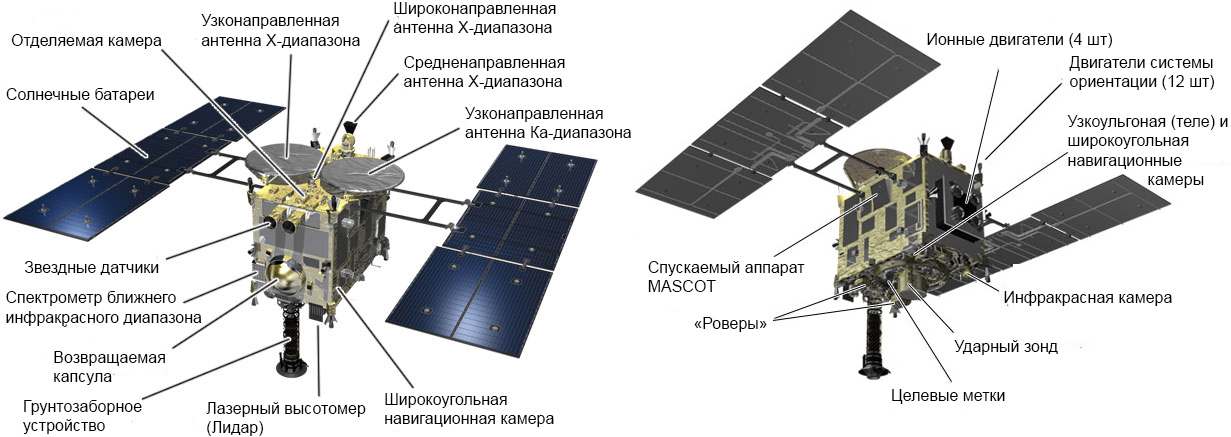
The probe is equipped with three navigation cameras of visible light range. One of them, “long-range” with a narrow viewing angle, but with a good magnification, has seven light filters that allow you to make colored frames. Two cameras - black and white wide-angle, for easy viewing of the space and the choice of target for study. There is also a laser "scanner" - a lidar, analyzing the structure of the surface of the asteroid to simplify the landing.

Remote geological survey is supposed to be carried out using infrared cameras. One of them - the mid-infrared spectrograph - will allow to study the geological composition, and the second - in the far infrared - measures the surface temperature.
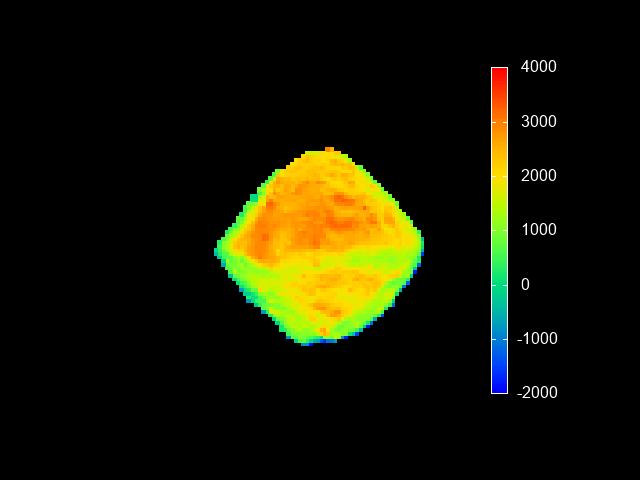
Hayabusa 2 carries a solid supply of tools for direct study of the surface: tantalum bullets to knock out and collect a little regolith, a shock impactor with explosives, three small movable Rover descendable probes from Japanese universities, and one MASCOT German-French traveling companion. The main task of Hayabusa 2 is to extract three portions of asteroid ground and return to Earth by the 20th year.
The Japanese machine became close to Ryugu in the summer of 2018.

The asteroid also turned out to be a “pile of stones” of the characteristic shape of a diamond, which appeared due to its loose structure and fast rotation.
A similar form was the asteroid Steins, examined by Rosetta .
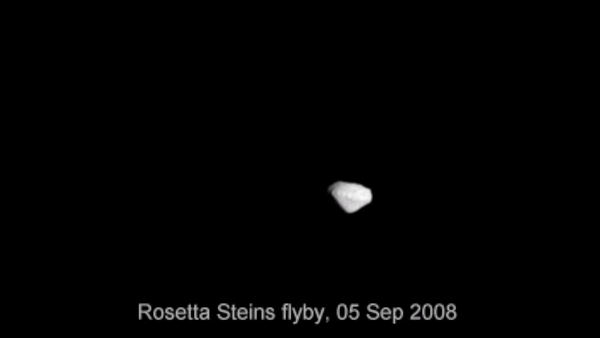
To date, a pair of Rover-1A and Rover-1B research vehicles, created by JAXA and Aizu University, are landed on Ryugu. These are small cylindrical devices with a diameter of 18 cm and a height of 7 cm, weighing about 1 kg. Equipped with cameras, thermometer and solar panels, so for some time with them we can expect new pictures.
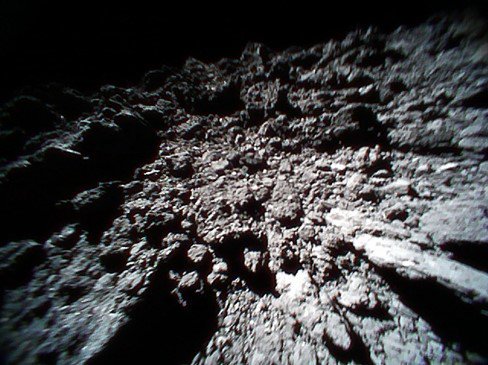
The MASCOT movable module was developed at the German Aerospace Center in collaboration with the French Space Agency. This is a 10-pound module in size and shape with a shoe box. It also has cameras and scientific instruments: an infrared spectrometer to determine the geological composition of the surface, a radiometer for high-precision measurements of the temperature of the soil, and a magnetometer to determine the magnetic field of the asteroid. MASCOT dropped on Ryuga on October 3, he made three jumps, and worked for three asteroid days or 17 Earth hours. Solar batteries for recharging him did not put, so his mission has already been completed, but some of the scientific data still remains on Hayabusa 2, so you can expect new images and information from MASCOT.
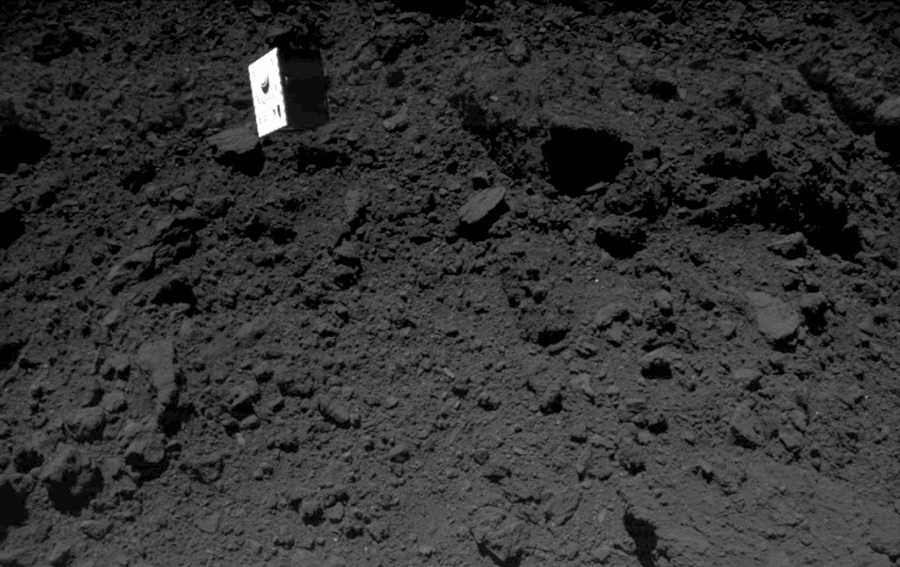
While on board the Hayabusa 2 remains the Rover-2. It is an octagonal one-kilogram apparatus measuring 15x16 cm, with two cameras, a thermometer and an accelerometer. It was created by the association of Japanese universities under the leadership of Tohoku University.
To compile a three-dimensional model of the asteroid and secure a close approach to it, a laser “scanner” - a lidar - is installed on board the Japanese probe. The device "fires" a cosmic body with laser beams, determining the distance to the surface. To simplify the work of lidar, the Japanese device stocked up five balls-tags with a reflective surface. The names of 180 thousand people who took part in the Messages from Earth campaign organized by the US Planetary Community were put on one of the light-reflecting wrappers.

Hayabusa 2 must collect soil from three points of the asteroid. Moreover, two samples will be taken from the surface, and the third will try to take from the bottom of a man-made crater, which will be knocked out with the help of explosive charge. Impact probe (impactor) is a cumulative charge on the principle of " shock core ". The explosive is needed because the speed of the probe relative to the asteroid is small and a crater will not create a simple collision.
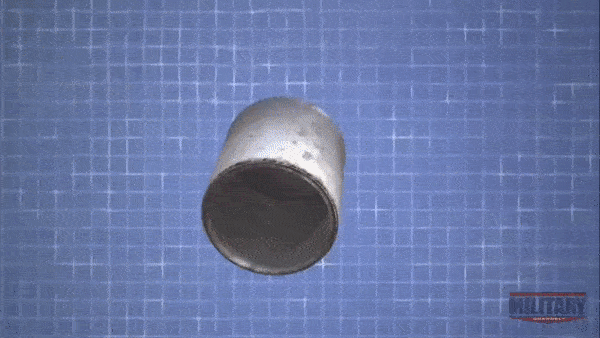
The problem of observing the impactor’s moment of impact into an asteroid was solved unbanally. Since the detonation of the charge and the release of the regolith are dangerous for Hayabusa 2, at the time of the explosion it will be on the reverse side of Ryugu and will not be able to observe the impact. Together with the separation of the impactor, the Hayabusa 2 will separate the DCAM3 flying camera, which should capture the moment of explosion and release of rock. The detachable camera is a practically independent spacecraft with optics, a radio data transmission system, a rechargeable battery, and a passive thermal management system. DCAM3 has a cylindrical shape, and stabilization by twisting. At the moment of separation, at a distance of 1 km from the impactor’s impact point, the camera will be aimed at the collision site, and twisted like a top on the optical axis, which will allow it to always look in one direction. After shooting, the camera will have one hour to transfer all the pictures to Hayabusa 2.
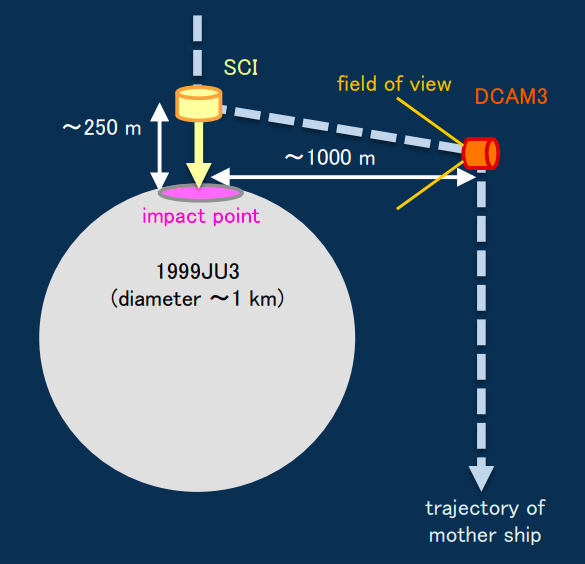
The asteroid's tool for collecting soil samples is the one that was on the first Hayabusa, and only slightly modernized. Due to the low gravity of the asteroid, landing on it resembles a docking of spacecraft rather than the usual landing operation on Earth, Mars or the Moon. Therefore, Hayabusa 2 itself will not land on the asteroid, it will release a telescopic bell that will bring it closer to the surface. At this time, from the inside of the socket, bullets will be fired at the asteroid, and the fragments knocked out by them will fall into the soil collector. Such an operation will be repeated three times, and for the third time it will be necessary to precisely “dock” with the crater left by the explosives.

The process of rock mining will be monitored by a separate chamber, for the installation of which students collected funds by crowdfunding. The spacecraft has already held several rehearsals for rendezvous with an asteroid, but scientists are not in a hurry to carry out the first capture of the ground.

After the rendezvous and preliminary inspection of the asteroid, the scientists sounded the alarm. It turned out that on the surface there are practically no flat areas with loose regolith where one could go down and take samples. Everywhere there are large and small stones, for which the Hayabusa 2 soil collecting device is simply not adapted. So far, several target sites have been selected on the asteroid, with small stones, from where it is supposed to seize the regolith.

The return of the Hayabusa 2 descent vehicle is expected in 2020, if the entire program is successful. Moreover, Hayabusa 2 itself will keep a supply of fuel to go to study another near-Earth asteroid.
In general, the Hayabusa 2 mission demonstrates the possibilities that the modern microelectronic revolution offers. Even a relatively small interplanetary spacecraft can not only independently explore space, but also becomes the carrier of many small, independent spacecraft, which greatly expand the capabilities of scientists and allow students and the general public to engage in cosmonautics.
Source: https://habr.com/ru/post/428261/
All Articles